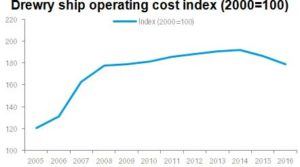
Operating expenses (OPEX) are a key elemen[ds_preview]t in the tough market environment for years. According to shipping consultancy Drewry, there has been a positive trend, but the outlook is narrow.
»The cost of operating cargo ships has fallen for two successive years but is forecast to rise in 2017 and beyond«, it says in its latest Ship Operating Costs Annual Review and Forecast 2016/17.
A couple of weeks ago already, the »HANSA Opex Survey«, published during the 20th »HANSA Forum Shipping | Financing«, revealed widespread reductions in operating expenses. However, caution should be taken when interpreting the results over time, it said.

Drewry writes about 2016 as another very difficult year for most shipowners and operators. »Weak freight rates, declining asset values, eroded profitability and denuded cash balances have forced shipowners to reduce costs wherever possible, and vessel operating expenses have been no exception« the report states.
OPEX across 44 different ship types and sizes would have shown that shipowners have trimmed costs in 2016 for the second successive year. According to the market report, the average decline in total ship operating costs among the vessel categories covered was 4.4%. This comes after a fall of 1.5% in 2015.
»In the short term, it is evident that the direction of the wider cargo shipping market will continue to shape trends in operating costs. That said, the scope for further significant cost reductions is limited. We are still of the opinion that costs will rise in 2017 and beyond, but perhaps at lower levels than previously anticipated,« comments report editor Nikhil Jain.
Drewry anticipates modest increases in manning costs as a result of international wage rate agreements and shortages in certain officer ranks. Excess capacity in the insurance sector and competition among insurance providers will help offset the impact of rising asset values on the H&M market.
»Although the cargo carrying fleet is relatively young, spending on R&M is expected to rise. Recent legislation regarding the retrofitting of ballast water management systems will lead to increased expenditure, so it is safe to assume that expenditure on R&M (repair and maintenance) will rise at rates above typical inflation,« adds Jain.



















